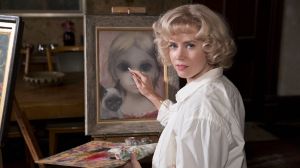Big Eyes
-from contributing editor, Andy Ray
Amy Adams is currently our greatest American actress. She reenforced my opinion with her recent performance in Big Eyes. Two years ago, she should have won Best Supporting Actress for her small but important role in Paul Thomas Anderson’s The Master. She wasn’t even nominated. Last year, she was a shoo-in for Best Actress with her commanding performance in David O. Russell’s instant classic, American Hustle. Not only did she lose the award, she lost it to  Cate Blanchett in Woody Allen’s Blue Jasmine. Naming anyone the best actor or actress in a Woody Allen movie is something akin to saying one of the guys in One Direction is a better singer than the others – it may be true, but who cares?
Cate Blanchett in Woody Allen’s Blue Jasmine. Naming anyone the best actor or actress in a Woody Allen movie is something akin to saying one of the guys in One Direction is a better singer than the others – it may be true, but who cares?
Currently, Adams is starring in Tim Burton’s Big Eyes, an accounting of 1960s artist Margaret Keane, whose paintings of children with disproportionately large eyes became famous when they were fraudulently “stolen” and publicized by her husband, Walter Keane. You see, Walter Keane always wanted to be a great artist, but he simply did not possess the talent. What he did possess was an ample (nee overflowing) supply of salesmanship. Keane was the type of guy who could sell snow shoes to a polar bear. In the old west, he would have been the huckster who traveled from town to town hawking the latest elixirs from the back of his wagon. He’d then skip town before anybody realized his potions were phony.
Meanwhile, his wife, Margaret, was the painter Walter always wanted to be, but her docile temperament prevented her from tooting her own horn. She was meek on the outside, yet quietly confident (at least of her art) on the inside. Enter Walter Keane – but with the caveat that he claim her paintings as his own. By the time he convinces Margaret to cooperate in the scam, it’s already too late. However, this is the late 1950s and early 1960s – a time when women were not readily accepted in the art world, and a time when no serious art critic or connoisseur would even listen to a woman talk about art. And the Keanes were struggling newlyweds; heaven knows they needed the money.
Then the paintings (and Walter Keane) became famous. Very famous. And poor Margaret desired the credit for her own paintings. Walter would not agree. He absolutely loved living in the public spotlight. Can you see where this is going? I thought I did too, but this picture culminates in a courtroom scene that’s more thrilling than most. And watching Adams’ Margaret Keane gain strength throughout Big Eyes is a true joy. I know I sound like a broken record when I say Amy Adams is perfect in this film, but Amy Adams is (once again) perfect. She hits all the right notes. Her acting accomplishment rivals those of Felicity Jones in The Theory of Everything and Reese Witherspoon in Wild, as the best I’ve seen from any actress this year.
And what a departure from her bold, self-assured con artist role in American Hustle. Many actresses are associated with a certain type of character. Audrey Hepburn always played the classy lady. Jane Fonda always played the righteous woman. What’s Amy Adams? Anything she wants to be! For my money, she’s our best actress since Meryl Streep.
And who better to play the conniving art peddler Walter Keane than Christoph Waltz – a man who’s already won Best Supporting Actor Oscars for the past two Quentin Tarantino films – Inglourious Basterds and Django Unchained? Waltz could probably waltz through the Walter Keane role in his sleep (pun intended), but he manages to give Keane an added dimension of deceitfulness that provides the catalyst for Margaret to leave him and dissolve their marriage.
And what a fabulous job of directing from Tim Burton – one usually so engrossed in his own stylish morbidity that his stories often become afterthoughts. Not so here. Burton uses a minimalist touch with Big Eyes, which allows his actors the ability to shine through a somewhat predictable tale. It’s Burton’s best picture since 1994’s Ed Wood.
Let me close by stating that I know next to nothing about art. By contrast, my love of, and knowledge of, music helped the recent Whiplash hit a home run for me. Here, I was lost amongst a theatre full of viewers who probably knew more about art than I. I loved this film. From my experience, I can tell you not to avoid Big Eyes simply because its subject matter may be of no interest to you.
See Big Eyes! You’ll be glad you did.